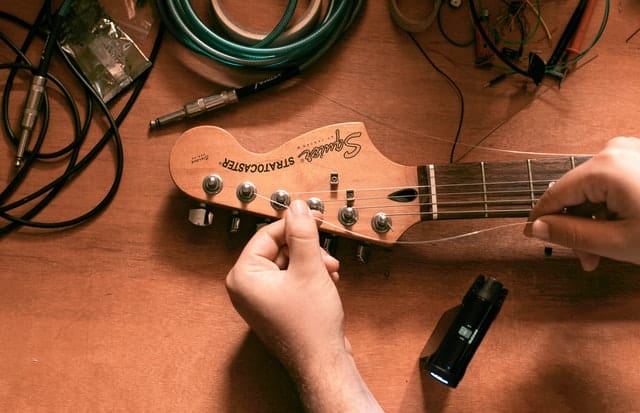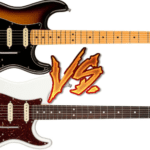Even with the convenience of the affordable clip-on tuners, we have today, sometimes it can seem like you spend more time tuning your guitar than actually practicing.
And if you perform live you certainly don’t want your instrument to go out of tune by the end of every song.
Since the Stratocaster and its imitators are so popular let’s see if there is anything that we humble end users can do to make life easier.
Stratocaster-style guitars can have certain issues with their tuning stability, mainly because of manufacturers skimping on the quality of some parts they use. Most issues are resolved with high-quality tuners and a properly lubricated matching nut. Also, it helps to be careful with the tremolo bar.
Some of the methods in this article involve modding your guitar and should be carefully considered but others can be done with things you probably have around your home already so there’s something for everyone.
A lot of these tips can apply to models other than Strats too.
Is the Stratocaster a model with natural tuning issues?
I don’t consider the Stratocaster to be particularly susceptible to going out of tune, sitting somewhere between a Telecaster and a Gibson Les Paul.
There isn’t a drastic break angle as the strings pass over the nut to the headstock like with Gibsons (the string tree on the Strat headstock does this subtly) but then there is commonly a tremolo system that you don’t have to worry about with Teles.
But if you don’t use the tremolo arm (much) you should have a pretty solid guitar once it’s set up.
What might be causing tuning stability problems on a Strat?
On a Stratocaster with decent tuners, the most likely culprit for tuning issues is the nut.
Strings can get bound up in the nut slots and this prevents the tuners from exerting the proper tension on the string (and you will break your strings when you try to tune).
Using the tremolo arm increases this chance of course since you’re moving the strings.
Another potential problem area for unwanted friction is the bridge saddles, especially if the strings have worn grooves into them but this isn’t as common as problems at the nut.
Tips to improve the tuning stability on a Stratocaster
So what can you do?
I don’t really think that the string tree(s) cause a lot of problems so starting with the tuners and assuming they are good quality when you restring your guitar there are methods of wrapping the strings around, under, and then over before winding to trap the strings in place and prevent slippage.
You can find many tutorials for this online. Make sure that you have some slack in the strings for winding and stretch your strings as you tune! This will prevent problems over the next few days as the strings become accustomed to their new lives.
Now the most important part is making sure the strings don’t get caught in the nut slots. If the nut isn’t cut deep or wide enough then it should be filed to ensure tuning stability.
This applies if you are putting larger gauge strings on your guitar too, like switching from 9-gauge to 11-gauge.
If someone at the factory had a case of the Mondays and the nut is cut too deep already then sorry, it’s probably time to get a new nut installed.
Something that you can do easily at home is lubricating the nut slots with lubricant or crushed pencil lead (graphite).
It’s quick and easy to do and it makes a big difference so I always do it when I change strings and I recommend that you do it too (on any style of guitar).
In regard to serious issues with strings sticking in the bridge saddles that probably means a trip to the repair shop unless you are comfortable replacing the bridge yourself.
I guess filing the saddles is technically possible but I’ve never heard of anyone doing it so who knows?
Finally, if all of the main problem points are taken care of there shouldn’t be more tuning issues, right?
Unfortunately, changes in temperature and humidity can cause your neck to shrink/swell and move, and this will affect your tuning as well.
I live in a humid climate so I always keep my number one guitar in its hardshell case and anytime I get something with silica/desiccant packets I save them and put them in the case.
Over time they will get noticeably stiffer so they are definitely sucking up some moisture and I like to think it makes a difference.
Tuning stability on hardtail Strats vs tremolo
A Strat with a hardtail bridge instead of tremolo is obviously a better choice for tuning stability since it takes moving the strings out of the equation.
For this reason, a lot of musicians will “lockdown” their tremolo by adding extra springs inside the back cavity and just not use the tremolo, effectively making it a hardtail guitar without replacing the bridge.
Is it normal for a Strat to go out of tune after using its tremolo?
Early Stratocasters were designed with a 6-point tremolo system but Fender later switched to a 2-point style that is a little easier on tuning. If your bridge, tuners, nut, and saddles are all high-quality material and set up correctly you shouldn’t have too many issues.
But of course, there is a limit to everything so if you throw a monkey wrench by going crazy on the whammy bar then as they liked to say in the recent mafia film The Irishman: “It is what it is.”
Could locking tuners help keep a Strat in tune?
If your nut is cut perfectly and lubricated but your strings are still slipping in the tuners or the tuners themselves are wonky, you could try dropping in locking tuners. They have the added benefit of making it quicker to change strings as well. But they’re not cheap and sometimes involve drilling new holes in your headstock.
Personally, I’m not sold on the idea, I mean Hendrix was pretty rough on his Strats and he didn’t have locking tuners.
But I admit they are becoming more popular and come stock on quite a few guitars these days so maybe I’m just being a stick in the mud.
If you think they’re a good fit for you, you can check out some nice choices for Stratocasters right here:
How often should you tune your guitar?
Personally, I usually check the tuning of my guitar before I use it or if something starts to sound off and I think that’s pretty standard.
You may do it more or less often and if you are worried that you are lazy or obsessive-compulsive then here’s an article to see if you’re abnormal:
Basically, you just don’t want to have to tune your guitar between every song or two, especially if you are playing live somewhere.
If you have followed music gear for a few years you probably remember the debacle with Gibson putting robot tuners on all their guitars.
It didn’t go over too well; they required batteries, were expensive to repair, and most people just didn’t like them.
Why? Well, I don’t mind tuning my guitar occasionally and I don’t think I’m alone.
It’s just part of playing guitar, part of the ritual that we’re used to.

Hello there, my name is Ramiro and I’ve been playing guitar for almost 20 years. I’m obsessed with everything gear-related and I thought it might be worth sharing it. From guitars, pedals, amps, and synths to studio gear and production tips, I hope you find what I post here useful, and I’ll try my best to keep it entertaining also.





